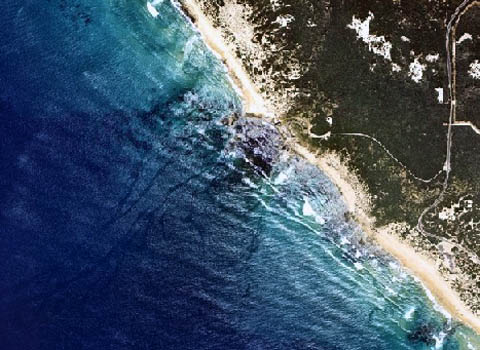A
Primeval Tide of Toxins
by Kenneth R. Weiss on 30 July 2006 in The
Los Angeles Times
The 'rise of slime' is killing larger species and sickening people.
Moreton Bay, Australia -- The fireweed began each spring as tufts
of hairy growth and spread across the seafloor fast enough to cover
a football field in an hour.
When fishermen touched it, their skin broke out in searing welts.
Their lips blistered and peeled. Their eyes burned and swelled shut.
Water that splashed from their nets spread the inflammation to their
legs and torsos.
"It comes up like little boils," said Randolph Van Dyk,
a fisherman whose powerful legs are pocked with scars. "At
nighttime, you can feel them burning. I tried everything to get
rid of them. Nothing worked."
As the weed blanketed miles of the bay over the last decade, it
stained fishing nets a dark purple and left them coated with a powdery
residue. When fishermen tried to shake it off the webbing, their
throats constricted and they gasped for air.
After one man bit a fishing line in two, his mouth and tongue swelled
so badly that he couldn't eat solid food for a week. Others made
an even more painful mistake, neglecting to wash the residue from
their hands before relieving themselves over the sides of their
boats.
For a time, embarrassment kept them from talking publicly about
their condition. When they finally did speak up, authorities dismissed
their complaints — until a bucket of the hairy weed made it
to the University of Queensland's marine botany lab.
Samples placed in a drying oven gave off fumes so strong that professors
and students ran out of the building and into the street, choking
and coughing.
Scientist Judith O'Neil put a tiny sample under a microscope and
peered at the long black filaments. Consulting a botanical reference,
she identified the weed as a strain of cyanobacteria, an ancestor
of modern-day bacteria and algae that flourished 2.7 billion years
ago.
O'Neil, a biological oceanographer, was familiar with these ancient
life forms, but had never seen this particular kind before. What
was it doing in Moreton Bay? Why was it so toxic? Why was it growing
so fast?
The venomous weed, known to scientists as Lyngbya majuscula, has
appeared in at least a dozen other places around the globe. It is
one of many symptoms of a virulent pox on the world's oceans.
In many places — the atolls of the Pacific, the shrimp beds
of the Eastern Seaboard, the fiords of Norway — some of the
most advanced forms of ocean life are struggling to survive while
the most primitive are thriving and spreading.
Fish, corals and marine mammals are dying while algae, bacteria
and jellyfish are growing unchecked.
Where this pattern is most pronounced, scientists evoke a scenario
of evolution running in reverse, returning to the primeval seas
of hundreds of millions of years ago.
Jeremy B.C. Jackson, a marine ecologist and paleontologist at the
Scripps Institution of Oceanography in La Jolla, says we are witnessing
"the rise of slime."
For many years, it was assumed that the oceans were too vast for
humanity to damage in any lasting way. "Man marks the Earth
with ruin," wrote the 19th century poet Lord Byron. "His
control stops with the shore."
Even in modern times, when oil spills, chemical discharges and other
industrial accidents heightened awareness of man's capacity to injure
sea life, the damage was often regarded as temporary.
But over time, the accumulation of environmental pressures has altered
the basic chemistry of the seas.
The causes are varied, but collectively they have made the ocean
more hospitable to primitive organisms by putting too much food
into the water.
Industrial society is overdosing the oceans with basic nutrients
— the nitrogen, carbon, iron and phosphorous compounds that
curl out of smokestacks and tailpipes, wash into the sea from fertilized
lawns and cropland, seep out of septic tanks and gush from sewer
pipes.
Modern industry and agriculture produce more fixed nitrogen —
fertilizer, essentially — than all the Earth's natural processes.
Million of tons of carbon dioxide and nitrogen oxide, produced by
burning fossil fuels, enter the ocean every day.
|
